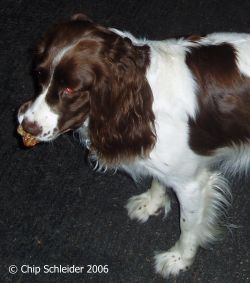
 Late spring in Virginia is truly of work of divine art. Viewed from the air, it is an incredible, vast mosaic of color: greens from the budding poplars and oaks, pinks from the red bud trees and whites from the dogwoods. The chill of the early morning air surrenders gracefully to the pleasant warmth of the mid-day sun. The gold finches, robins, doves, tufted titmice, blue jays, wrens, chickadees, hummingbirds, red tail hawks, cardinals, blue birds and the periodic quail resume their traditional places in our garden. The garden is a labor of love of Door, my bride and
best friend of thirty years. A devotee of all nature and animals, Door has toiled long and hard to provide our backyard with bountiful habitat that plays host to an incredible diversity of wildlife. In addition to the aforementioned rich variety of birds, our backyard is a home to squirrels, chipmunks, rabbits, foxes, deer, snakes, field mice, multiple species of butterflies, bees of all types and last but not least toads. Door is especially attached to her toads. Her affection for these ungainly but useful creatures no doubt has been re-enforced over the years by cohabitation with yours truly and our two sons; the males perhaps in her feminine mind bear some resemblance to the stalwart toad. However, it is perhaps best to brush only lightly on that comparison.
It is the toads of the yard that concern us in this installment of the Dixie Chronicles - although the casual reader might ask what in the name of creation do toads have to do with spaniels? Patience, please, gentle reader, for the problem all began in the warm weeks of late spring.
I had been working diligently with Dixie in preparation for the upcoming hunt test season. Seeking desperately to undo the harm I had done the previous fall when I had taken a perfectly steady to flush and shot English springer spaniel, wound her up tighter than a fifty cent watch and unsteadied her in a manner of minutes on wild pheasants in the cornfields of South Dakota. The problem was serious. Dixie was incredibly steady to thrown dummies, dead fowl trainers with feathers, tennis balls and socks saturated with bird scent as she quartered in the shin high grass of our neighborhood’s common area. If it was made of plastic, canvas, cotton, pheasant feathers or duck scent impregnated wool, her butt was glued to the ground when the object of her desire was airborne.
She twitched not a muscle until I released her with a gentle command of "Dixie". I was getting downright smug as each day I swaggered back from the field with a newly found confidence in my dog and training abilities. Flying too high, like the youthful Icarus of Greek mythology whose artificial wings made of wax and feathers were melted by the sun as he vaingloriously soared too high and then plunged helplessly into the sea, I was ready to do a belly flop of my own. For when I ran Dixie on live birds in the field to further her preparations, she broke - and broke badly.
"And there I witnessed, to my undying amazement, Dixie with her body in what can only be described as a dyed in the wool, honest-to-gosh, Rick Smith-be-proud... point."
Dixie had passed her Junior Hunter the previous year. I felt extremely confident that she would have minimal problems with the Senior Hunter level. My strategy was to keep her steady through Senior Hunter then move directly into the Master Hunter test. By this time, she was performing very well on hunt deads and could do a reasonable water blind. Well perhaps reasonable water blind is a slight exaggeration. She could stumble through the thing. Her marked water retrieves were up to snuff and she was quite line steady to thrown birds as well as dummies. It was the land series that posed the greatest challenge, and try as I might I could not re-steady her. No amount of whistling, arm flailing, check-cording, coaxing, cursing or chasing could keep it from happening.
I was at a loss. The acerbic wit, James Thurber, perhaps captured my mood perfectly with the line, "One martini is all right. Two are too many, and three are not enough." (Don’t worry. I promise I will get back to the toads.)
In desperation, I did what any sane amateur gun dog trainer would do. I called a professional, in this case - in fact in all my cases - Tony Roettger, and we reviewed the options. After much deliberation on the pros and cons, Tony and I decided that I needed an electronic collar. I know. I know. In our book, Urban Gun Dog, Tony and I discourage the use of an electronic collar for the beginner. We do so primarily to keep novice trainers and handlers from making significant mistakes with their dogs that are not correctable or only correctable with a large investment of time and dollars. Tony uses an electronic collar only to spot correct problems that he cannot correct by any other means - and only after the dog has learned the required command.
In Dixie’s case, she had been steadied and thus knew the command. I would use the collar only to re-enforce steadiness - not teach it.
So decided, I embarked on my journey by purchasing the collar. I invested significant amounts of time in collar conditioning Dixie, not to mention studying up on electronic collar training techniques. She wore the e-collar every time we went out of doors for three weeks without me taking the transmitter or turning on the e-collar. She so thoroughly associated the collar with play that she began to jump in the air with excitement whenever I brought the damn thing out to train. To this day, she whines and springs into the air with the promise of a day in the field whenever I bring out the e-collar. I actually must hide it from her to keep her from thinking we are going to outside play when I recharge it. (I have not forgotten the toads).
It took only three or four "nicks" of the collar on an extremely low setting to re-steady Dixie to birds after I hit the whistle to hup her. She has remained steady ever since. Oh, admittedly, her brakes have gotten a little squeaky now and again over the years - especially after a day or two in South Dakota on wild pheasants. But in the main, she has stayed rock steady to flush and shot since I retrained her by means of the e-collar. Whenever I feel that she is beginning to think about breaking, I will bring out the collar, to Dixie’s immense pleasure, and gently remind her of the reason dogs stop after putting up a bird should she for some reason ever forget. (Now back to the toads).
It happened one night not long after I re-steadied our girl. Door had taken both Dixie and Arwen, my field bred English cocker, outside to take care of their business prior to retiring. Door poked her head in the house and said in her lovely Georgia drawl, "Honey, you need to come out here and see this. Something is funny with Dixie."
Quickly I joined her in the front yard. And there I witnessed, to my undying amazement, Dixie with her body in what can only be described as a dyed in the wool, honest-to-gosh, Rick Smith-be-proud... point. "Mother of gods!" I exclaimed, "what the hell is happening with her?"
The springer was locked up tighter than a college sorority dormitory on a Sunday night, and was pointing a small rotund stationary object, about the size of one of Door’s famous biscuits, on our driveway. It was - you guessed it - a nice sized toad. The toad moved; Dixie shifted positions and went back on point, her forepaw lifted stylishly with tail straight back. Where had she learned that? "No more Outdoor Life Network bird hunting shows for her," I thought to myself.
What had caused this? Did I overenthusiastically use the e-collar? I reviewed Dixie’s re-steadying training mentally. She had never blinked or intentionally avoided a bird in the field. She had not developed the creeping or soft flush. Both of these are disastrous outcomes of an injudicious application of electrical power from a collar to a hard charging spaniel during the steadying process. Just the opposite, Dixie had retained her hard drive and aggressive bird flushing notwithstanding the infrequent "nicks" I applied while I re-steadied her. I racked what little is left of my brains to divine a cause for the pointing spaniel... to no avail.
Door was no help in this matter. Doubled over in laughter and having difficulty getting her breath, she sputtered, "Well at least she finally points something. Maybe you can now bring home some grouse."
"Wives," I mused to myself.
Although she has never pointed a bird in the field, Dixie continues, to this day, to point toads. Every summer evening finds her on the hunt for toads near our driveway. She points them with panache and flamboyance that the best German short hair owner would envy. I have never figured out what started her down this path. Door still calls me out from the house to witness the scene. "Master Hunter," she periodically jibes, "no doubt."
Not long ago, I was comforted by a bizarre event. Dixie had pointed yet another toad during her nocturnal meanderings, but I called her off her quarry and she bolted inside. Unbeknownst to me, the springer had snapped up a large toad and was holding it in her mouth as I lead her up the stairs to her kennel. Dixie went into her kennel and nested in her usual fashion on the fuzzy white mat that pads the bottom. I switched off the light and had just returned to my room to enjoy my nightly ritual of approximately two minutes of a good book before zonking out for the evening when I heard Dixie begin to bark. Barking is something she very rarely does once in her kennel.
Door beat me to the kennel and switched the light on. When I joined her in the room, she was holding a round fuzz-covered lump. It was a toad that Dixie had secreted in her mouth but which had gotten away from her. It was covered in fuzz from the pad in Dixie’s kennel and sat square in the middle of Door's palm. All of a sudden the toad, no doubt traumatized by recent events, released a prodigious amount of urine into her hand. As the liquid dripped off of my wife’s hand and ran down her arm, I said, "Honey, if you kiss that thing, maybe it will turn into something really, really special."
Author’s note: this is the seventh in a series of articles that chronicle both the development of a talented young spaniel and the rights of passage of an inexperienced trainer and handler.
|
|
| Bookstore | Bill Fawcett Reviews | Bookshelf | Advertise | Classifieds | Resources | Events | Point Standings | Archives | |
|
|
Copyright © Spaniel Journal & L Baughan Webdesign, 2002-2006, all rights reserved worldwide |
|

